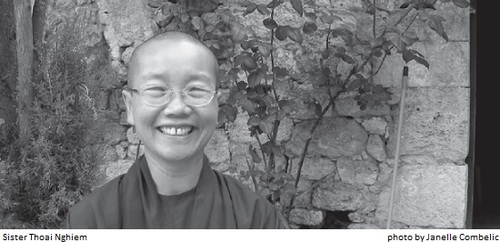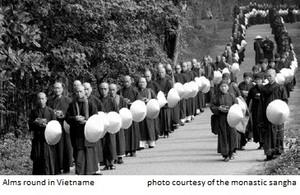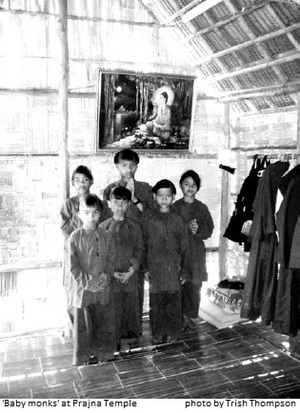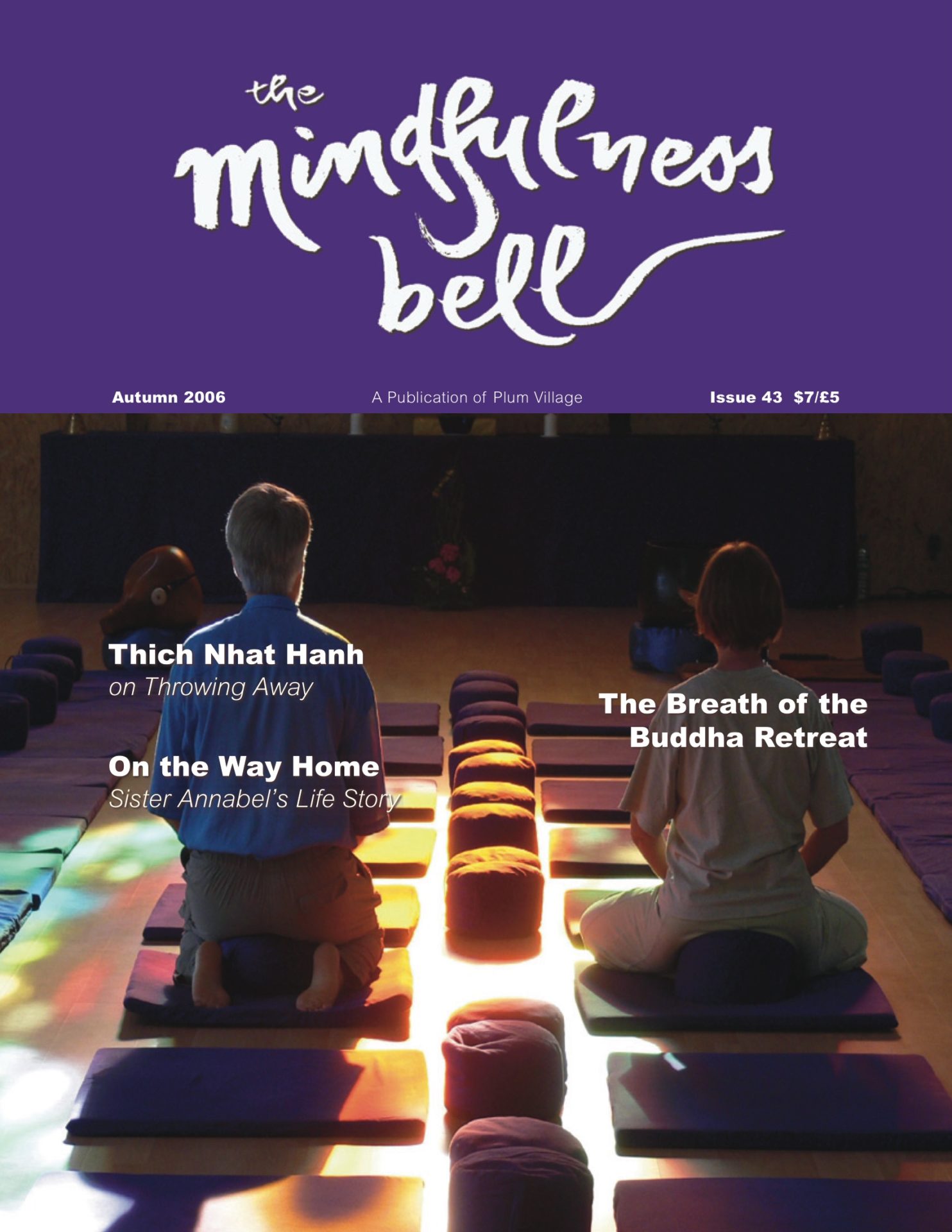By Jane Ellen Combelic in October 2006

I found Sister Thoai Nghiem at Lower Hamlet before the Breath of the Buddha retreat, mindfully hacking away at overgrown bushes behind the Dharma Nectar Hall. We met for this talk after the retreat, on June 25, 2006.
Mindfulness Bell: You’ve spent a lot of time in Vietnam since Thây’s trip early last year.
By Jane Ellen Combelic in October 2006

I found Sister Thoai Nghiem at Lower Hamlet before the Breath of the Buddha retreat, mindfully hacking away at overgrown bushes behind the Dharma Nectar Hall. We met for this talk after the retreat, on June 25, 2006.
Mindfulness Bell: You’ve spent a lot of time in Vietnam since Thây’s trip early last year. There are two monasteries in Vietnam now that practice in the tradition of Plum Village—Tu Hieu (Thây’s root temple) in Hué and Bat Nha (Prajna Temple) in the south. How did that come about, and what has happened since then?
Sister Thoai Nghiem: During the trip Thây gave ordination to nineteen young people. They had applied to be monastics the year before, when several brothers and sisters and I came there to give teachings. So we sent them to Tu Duc Temple in Cam Ranh, whose abbot had come here to practice. We asked him to babysit them and he gave them guidelines of the practice. When the trip took place Thây gave ordination to them at Hoang Phap Temple [outside of Ho Chi Minh City] during the monastic retreat, with more than one thousand monastics. That was the first batch of Thây’s new students.
Two Dharma teachers, monks of Plum Village, agreed to stay behind in Hué to look after the six novice brothers ordained by Thây and fifty young men aspirants in Tu Hieu root temple. And Sister Bich Nghiem, a Dharma teacher from Plum Village, also kindly accepted to look after the twelve novice nuns and sixty new young women aspirants in Dieu Nghiem nunnery.
After Thây went back to France, the rumor circulated that you can practice engaged Buddhism in Thây’s style in Vietnam if you join Tu Hieu monastery or Dieu Nghiem nunnery. More aspirants kept coming to both temples, and after a couple of months Dieu Nghiem became too small. So we made the decision to move all of them to Prajna because it has more space.
So that’s how it started. When we first came to Prajna, we had seventy or eighty. But soon right after that, hearing of our presence, people started coming—more and more and more—and within a year we got up to two hundred nuns and aspirant nuns.
Mindfulness Bell: How many people were living at Prajna before you came with the nuns from Dieu Nghiem?
Sr Thoai Nghiem: There were no young nuns. Along with the abbot, Thây Duc Nghi, the residents consisted of a couple bhikshus [monks] and some very young novices, and two or three old bhikshunis [nuns]. They lived in the main house, and we moved into the place that was built supposedly for the elderly—the one where we stayed at night when we were there with Thây, a little bit further away.
For the winter retreat, Thây Duc Nghi with the support of our Thây of Plum Village wanted Prajna to have both monks and nuns. In September Thây Phap Kham and Thây Nguyen Hai of Plum Village came and started setting up the monks’ side. At that point we clearly started to have two hamlets, one for nuns, named Rosy Hearth Hamlet, and one for monks, called Fragrant Palm Leaves Forest Hamlet. And they also had more and more monks coming, and started accepting aspirants. We are now one hundred ten monks and aspirant monks and two hundred twenty nuns and aspirant nuns.
Mindfulness Bell: What is happening there now?
Sr Thoai Nghiem: At Prajna before I left for three months here, nobody really wanted me to go. But I said I needed to have a break. It’s not really a break to come back here and have four retreats (laughter). And when I go back to Vietnam I will bring some of the sisters, over fifty, to move back to Dieu Nghiem temple.
There are so many people who love the Dharma and love Thây’s teaching but also there are some who say that Thây’s teaching is good but it applies only to the Westerners. A few of them who have come to Plum Village are impressed but say that they cannot do anything, especially in Hué, because Hué is too proud of their conservative tradition.
Mindfulness Bell: For many of us Westerners who are immersed in the Plum Village practice it’s difficult to understand the contrast with traditional practice in Vietnam. As I gathered from the trip, Buddhism in Vietnam has endured constraints for many decades because of the political regimes in that country and today there are signs of some corruption in monastic practice. What does the tradition look like today, and why is Thây’s teaching so revolutionary?
Sr Thoai Nghiem: My explanation is probably not a complete one. But some basic differences that I have experienced are that all the temples in Vietnam like to chant in Sino-Vietnamese; they have been doing it for hundreds of years and they have difficulty chanting in Vietnamese. They go for the sound more than for the meaning; and we go for the meaning.
And secondly, they go more for ritual. The tendency is to think that the more ritual you have, the more you win the trust of lay people. We focus more on the content and the transformation. One tradition, for example, is to have formal lunch with monks wearing orange formal sanghati robes, sitting on chairs around a table, while devoted lay Buddhists offer them food and prostrate to them in order to obtain merit. This is not the simplified way of formal lunch in Plum Village.

Even at Tu Hieu, Thây’s root temple, there was resistance. Before Thây’s return, we asked the monks in Tu Hieu to practice in Plum Village style: no private money except some monthly pocket money offered by the sangha ($3 per month), no private motorbike, no cell phone, no going to Internet except for sangha work and only with a second body, and so on. Two dozen monks left Tu Hieu because they could not live with these new trainings. But then forty new monks and aspirant monks filled in.
Another tradition is that they don’t let the sangha of bhikshus make decisions; the abbot has the authority to do everything. When I left the Rosy Hearth Hamlet of Prajna, even though I was not the abbess, just one of the oldest ones over there, some didn’t think that the hamlet of nuns could survive! I said, we have fifteen sisters from Plum Village working together, and if I leave, that directing sangha of fifteen sisters from Plum Village will take care of it. And I feel completely confident in leaving. It works! Thây put us into the position, where the decisions are made by the whole council of bhikshus or bhikshunis, not by one person.
Another example, as Thây has often said, here we don’t have individual money, individual cars, individual telephones. In Vietnam right now, most people get used to having their own money. If they go out and do a service [like funerals or rituals for ancestors] and receive money offered by lay Buddhists, that’s their own. In Plum Village when we are offered money we put it into the sangha budget.
In Prajna Temple right now, the abbot has requested that his old monastic students not have mobile phones, and they didn’t follow the rules. And finally the abbot had to ask them to go to another temple.
They love Thây’s Dharma talks, they love everything Thây says. Except they cannot live it. That’s why it’s difficult for them to give up everything and come and join the sangha and follow Thây’s path.
Many young people in Vietnam during the French colonization joined the jungle guerrilla to resist the French, as an ideal of service. Nowadays the young people in Vietnam have seen that being a monk or a nun in Plum Village style, with a very simple life full of joy in the practice, is an ideal of service too, and the number of those who aspire to become monks and nuns is increasing every day. For many months now, we have had to stop accepting new requests to join us because there is not enough space. Hopefully by setting up a nunnery in Hue we can accept more. We want to do it now because we see that it has been successfully done at Prajna and in Tu Hieu. In Tu Hieu the sixty-five new novice monks and the twenty old-style bhikshus have adjusted to the way of living in Plum Village style. It proves to all of Vietnam that Thây’s teaching is applicable; it responds to the needs of the younger generation who have the bodhicitta and would like to lead the monastic life as an engaged step to improve society in a happy way.
Mindfulness Bell: There’s also the gender issue in Vietnam that Thây is revolutionizing—where nuns are always subservient to monks, even if the monk is very junior to the nun. It must be hard for both men and women in Vietnam to learn a new way of being together in monastic life.
Sr Thoai Nghiem: The new aspirants who come in and become nuns under the tradition of Plum Village, they love it. In their life right now, they like that the monks and nuns are equal. The nuns that got trained in the traditional way, yes, they always feel like they are behind.
This makes me think of a story. We wanted to have an alms round for Prajna Temple, just before the Buddha’s Birthday, where we go around and ask for food. We did several of these during the trip with Thây and this was the first time it was done in Bao Loc.

But when we went as a committee to talk with the monk who has authority in the area, he said no. He said he would authorize it and join it on the condition that nuns would not be allowed to walk parallel to the monks. As you remember, our monks walk on one side of the street and nuns on the other side. He said no, he would not accept that. The second thing he asked is that no novices are allowed to go on an alms round, only bhikshus and bhikshunis are allowed. Our Plum Village monks told him that Rahula, an eight-year-old novice in the time of the Buddha, went on alms round for food too. But the traditional monk still refused. The third thing he asked was that we wear the orange sanghati robe. But Thây is a revolutionary, he wants us to go back to the traditional way of Buddhists in Vietnam; since Buddhism arrived in this country, monastics have worn brown, the color of poor farmer cloth, the color of the poor. We save sanghati for more ritual ceremonies.
So that high monk in Bao Loc refused to join us if we do not follow his requests according to the “traditional” way. Then we had to go on with our Plum Village way without him!
And it made a big impression on the people. We were there with 200 monks and nuns, most of them young, and they had never seen that. It was very beautiful. We just did what Thây did, we wore brown and our straw hats and carried our bowls.
Mindfulness Bell: How will Thây’s next trip be different from the previous one?
Sr Thoai Nghiem: Most people say it will be easier to organize than the last one, because we already know Vietnam and this is the second trip. But I don’t think so. Each trip has a different flavor, and Thây is an artist full of creative ideas. We have to trust that he will invent many interesting loving offerings to the nation during the trip, on the spot, and everyone will be happy.
But the second thing is that now we have so many people who know about Thây and I cannot predict the number of people who will come and listen to Thây.
We are busy trying to build some more facilities to host people when they come to Prajna. One thing for sure, every time we have a day of mindfulness, just among us, we already have three or four hundred people. We have a day of mindfulness for lay people once a month and we have up to eight hundred already. People come from all over Vietnam, relatives of those monks and nuns. And that’s without Thây! Just think if Thây’s coming!
I’m not sure if I’m exaggerating but I think it could be up to four thousand people coming or attending retreats. That’s quite a big job for us to do in organizing things over there.
Mindfulness Bell: You’re up to it! I admire you so much, Sister. I’ve heard you tell some stories from the last trip about the challenges you faced working on the accommodations for the lay delegation, challenges with hotel owners and so forth. How do you manage to keep your stability, your mindfulness in the face of so many challenges?
Sr Thoai Nghiem: Walking meditation! Follow my breathing! (laughter) I suppose that’s all. I always have to remember what Thây says—your practice is the most important thing.


